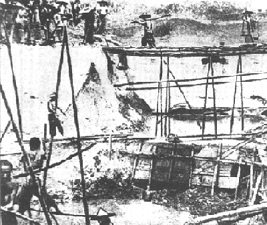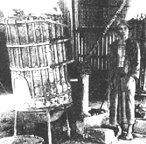How the
Chinese mined tin! For
many centuries, the Malays had mined for tin but their
methods were crude and ineffective. Between 1820 and
1830, the 2 states of Selangor
and Negri Sembilan
produced 200 tons of tin annually; in the 1880s Selangor
alone produced 4000 tons annually. This increase was due
to the arrival of Chinese miners who had new mining
methods.
The main Malay method was
panning (also known as lampan).
First, the miners chose a narrow valley with steep
grounds on both sides, soil was pulled down with a changkol
into the stream. The running water washed away the earth,
leaving the tin ore at the bottom of the stream.
 |
An open-cast tin mine with
workers carrying their loads on a primitive
wooden structure.
|
The Chinese
developed the open-cast method (or lombong).
Tin-bearing soil (karang)
was dug from the ground and puddled in a washing-box (lanchut)
to separate the ore from the soil. This method was
however prone to flooding, and was aggravated by the fact
that ore-rich lands were usually on low ground. This
method of mining was labour intensive, and it needed
skill in the control of water supply as well as the
efficient extraction of tin ore.
To tackle these problems, the
Chinese ingenuously adapted devices like the chain-pump,
water-wheel and bamboo water-pipes, used in the rice
fields of Southern China. With the arrival of the steam
engine in the 1880s, flooding became more effectively
controlled.
Tin ore was
smelted twice a year in a furnace. The furnace was filled
with alternate layers of mangrove-wood and charcoal. Tin
ore was fed in once the fire was ready, and more fuel and
tin ore were added in as required. Molten tin was then
drained off through a pipe at the bottom of the furnace.
 |
Picture of a miner and the
tin-refining furnace.
|
[
Back to Rebuilding Kuala
Lumpur ]
| 